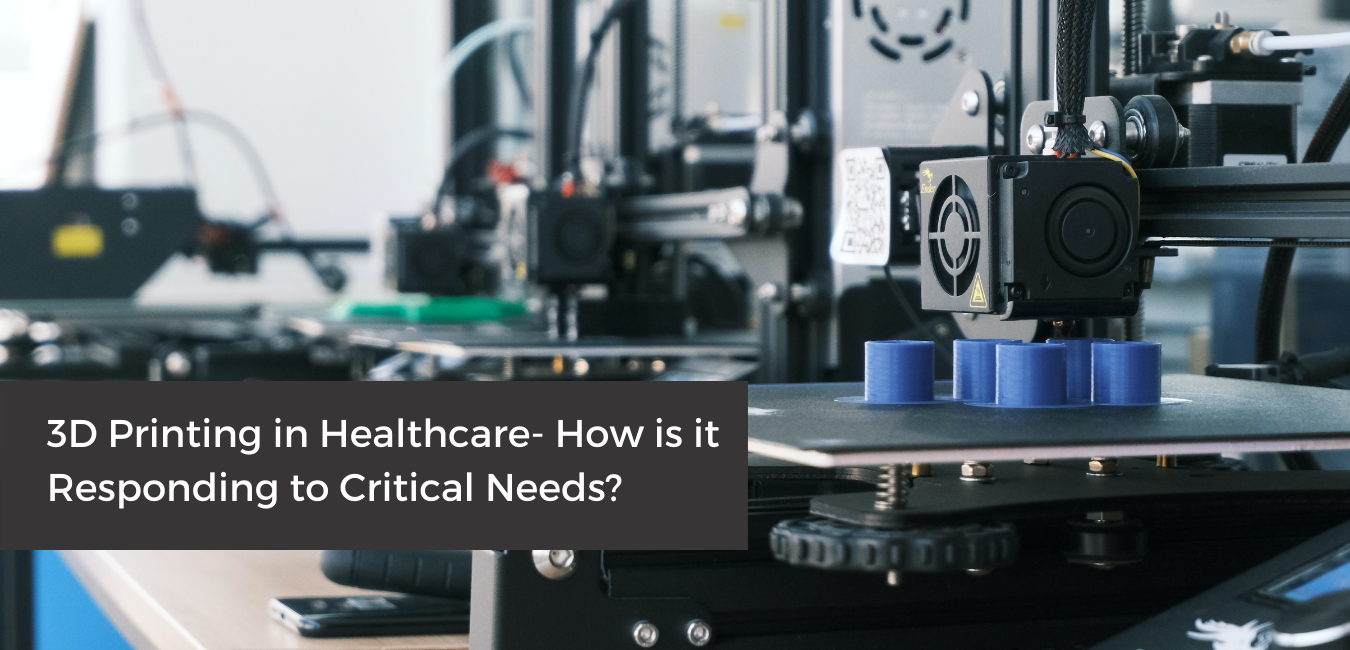3D Printing in Healthcare- How is it Responding to Critical Needs

The inclusion of different technological innovations is taking the healthcare industry to the next level. It's a global fact now that no one even tries to deny it. 3D printing is one such innovation that's transforming the medical industry for good.
Clearly, the potential of this invention is vast. In fact, as per a research firm, the 3D printing market will grow to around $6 billion by the end of 2027. A lot of sectors, including orthopedics and dental, are benefiting from this technology. Moreover, it provides new ways of customized care and enables providers to create better-performing medical devices.
Until the pandemic hit the world, this novel technique helped the medical industry in the following ways:
- Fabrication of anatomical replicas: In simple terms, doctors use this to clarify different aspects of disease diagnosis, thus improving treatment decisions and strategies. These models allow doctors to understand the patient's anatomy and use the technology to help patients understand medical procedures.
- Surgical tools: Earlier, the surgical instruments were made of titanium or aluminum. However, with the inclusion of 3D printing, surgeons can use it to make restorative treatments more precise. In fact, it's ideal for low-cost prototyping.
- Prosthetics: It won't be wrong to say that custom prosthetics are both time-consuming and expensive. However, with 3D printing, one could quickly produce patient-specific components, matching the user's anatomy.
But that was a pre-covid scenario.
Everything took a different course after the pandemic. This event put tremendous pressure on healthcare systems worldwide. The demand for medical equipment and supplies increased by multiple folds.
So, what changed? Let's find out now!
3D Printing in the post-Covid-era: What's Different?
Although the healthcare industry faced unprecedented circumstances, it showed remarkable resilience and delivered heroically despite all the challenges. But, the pandemic also put forth the need for healthcare transformation.
Simultaneously, the pandemic revealed that innovative technologies like 3D printing could support the patients and their critical needs. This is why there is a transition towards a future-oriented approach to healthcare. Here are some of the trends that you can expect in 2021 and the coming years.
- In 2020, healthcare materials saw a shortage due to disrupted supply chains. So, 3D labs quickly changed and adapted to circumstances. They redefined their strategy and shifted focus from printing anatomical models to printing protective equipment. In fact, it stands out as a reliable ally in the face of fluctuating supply chains. Thus, broadening its use in the healthcare sector. For now, 3D printing helps provide cost-effective medical devices on-demand. You can get everything from stents to surgical instruments made using a 3D printer. Experts suggest it will quickly replace the current systems and help the world get access to medical devices.
- With social distancing, everyone was looking for innovative ways to collaborate and communicate. Similarly, in the healthcare industry, the rapid use of digital tools improved the cases of remote diagnosis. And Point-of-care 3D printing labs are becoming effective and essential to fill the communication gaps between clinicians and patients. For instance, an online platform named Materialize Mimics Viewer improves digital communications and collaborations when sharing 3D patient models. This platform eliminates the need for any physical space to share feedback or treatment strategies with doctors or patients.
- Moving forward, you can expect advanced visualization technologies like VR/AR integrated with 3D printing applications. This will boost the visualization of clinical cases, especially for training purposes. Not only that, but it will also help with rapid prototyping, which can further help surgeons during surgical procedures.
- The use of 3D printing in hospitals will increase, thus further increasing the need for Quality Management Systems.
- The update in the DICOM standard will pave the way for integrating 3D printing and planning in the clinical workflow. One can easily archive or retrieve a 3D printing file. Thus, increasing the traceability of files. For instance, a new DICOM encapsulated OBJ file supported in MIS 24 was already released in May 2021.
- Like every other technology, 3D printing is also evolving and upgrading to meet the needs of today and tomorrow. Thus, one can easily access medical-grade 3D printers now. Also, the affordability associated with modern equipment will further facilitate the adoption of 3D printing in healthcare.
What Next?
- Let's not forget that the world is facing a massive crisis regarding the shortage of organs. Since 2013, the number of patients requiring organ donation has doubled, while the actual number of donors did not see much change. This is why scientists are working towards regenerative medicine. This involves using scaffolds, biomaterials, cells to create organs for transplants. 3D printing is playing a pivotal role in creating biomaterials using living cells and biomimetic synthetic polymers.
- The use of 3D printing in developing personalized or precision medicine. Including 3D printers in pharmacies and hospitals will help them take a dose or delivery system depending on the patient's body size, age, sex, and lifestyle. For instance, Aprecia Pharmaceuticals already approved 3D printed pharmaceuticals for epilepsy treatment.
- The healthcare industry faces a lot of issues regarding the R & D crisis. Using bioprinted tissues or organs would help to solve such problems. Thus, it will expedite the R&D process.
Final Takeaways
It is clear that 3D printing has a role to play in transforming the healthcare system. Moreover, this emergent technology is acting as a driving force to enhance personalized care. Not only can it help patients with customized implants, but it can also help address the ongoing global crisis by providing customized drug tablets.
In fact, in the battle against COVID-19, 3D printer companies helped provide medical products essential for patients. It is of utmost importance to continue advancement in this area to enhance agile and personalized patient care.
Undoubtedly, it's revolutionizing the healthcare industry in a plethora of ways. But, the 3D printing manufacturers need to abide by the rules to make the instruments and items made via this technology widely acceptable.
Are you looking forward to a world where you get a widespread access to prosthesis, fully-functional bio-identical organs providing another lease of life for millions?










